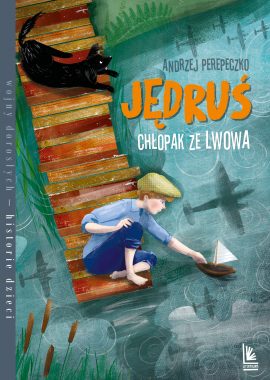Author: Andrzej Perepeczko
Illustrator: Magdalena Pilch
Year: 2019
Publisher: Literatura
Place of publication: Łódź
Pages: 144
ISBN: 9788376727165
Notes: “Wojny dorosłych – historie dzieci” series

©Wydawnictwo Literatura
Andrzej Perepeczko’s autobiographical story begins in inter-war Lviv. In 1935, the boy and his family move to Modlin near Warsaw, where they live until the outbreak of the Second World War. In early September 1939, the father, a lieutenant in the Polish Army, decides to send his family to the countryside. Jędruś finds himself in Luszawa, a town in the Lublin voivodeship. After the Battle of Kock is lost (in early October 1939), they leave for Warsaw. There are many more relocations in his young life, but the war comes to an end with Jędruś in Radomsko. The boy’s wartime travels mix with descriptions of everyday life under German occupation, including underground education, roundups, participation in the paramilitary Grey Ranks (Szare Szeregi) or news of the Warsaw Uprising.
The Holocaust appears in the book episodically. During his escape from Modlin, the protagonist notices that only Jewish people become victims of the bombings of Kock, and wonders: “why are the Germans bombing and burning such a little Jewish town? … After all, there is no target here that would be worth bombing” [37]. A short fragment is also devoted to the creation of the Warsaw Ghetto, whose “inhabitants” [64] (later also called “prisoners” [73]) have no right to go outside of its walls. The Poles cannot help them, which prompts Jędruś’s grandmother’s comment “we can … only pray for them, unfortunately” [64]. Interestingly, Perepeczko’s story does not follow the convention of a child character witnessing the Shoah. Jędruś’s grandmother explains why: “better not look at the ghetto, children, because people die in the streets there” [64]. The text also mentions the reduction of the ghetto’s area and the 1943 uprising resulting in the complete destruction of the “quarter encircled with a wall” [73–74].
Bibliography:
- Rybak, K., Stosunki polsko-żydowskie i Zagłada w polskiej literaturze dziecięcej XXI wieku, [in:] Stosunki polsko-żydowskie, vol. 2, Kultura. Literatura, sztuka i nauka w XX wieku, ed. Z. Trębacz, Warszawa 2020, pp. 171–187 (p. 174, fn. 7).